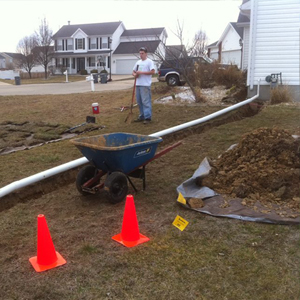Irrigation Pump Education
Click Here To Download Irrigation Pump Education
Irrigation Pump Education
The pressure is on. A customer has requested a pump for their irrigation system and they need it within 24 hours. Your palms start sweating. Your mouth goes dry. And your heart could likely pump blood to two full-grown adults at the rate it’s going.
Pause. Take a deep breath.
Helping a customer assess their pump needs doesn’t need to be an impossible task. By understanding the basic hydraulic formulas, pump varieties, and how to size a pump, you can better assist your customer in finding a pump that fits their needs perfectly.
The Magic Numbers: 0.433 and 2.31
Have you ever wondered how many “pumps” would inflate a basketball to the perfect PSI? 0.433 and 2.31 likely aren’t it, but when it comes to traditional pumps, these numbers are the right and left gates to the kingdom of hydraulics. In order to dive into the world of pumps, an individual needs a solid understanding of the vital function these numbers play. They are used in two ways:
1) Feet of Head to Pounds per Square Inch
To convert feet of head to pressure in PSI, multiply the feet by 0.433. One foot of water equals 0.433 PSI.
2) Pounds per Square Inch to Feet of Head
If you have the pressure but need to figure out the feet of the head, multiply the pressure by 2.31. One PSI equals 2.31 feet of water.
Gas or Diesel: Pump Varieties
Once you understand the importance of 0.433 and 2.31, you can confidently move on to the next step in the process—assessing what kind of pump the system needs. There are several varieties of pumps, but two of the most common are submersible pumps and above-ground centrifugal pumps.
Submersible Pumps
Submersible pumps are submerged underwater and out of sight, making them a great option for a homeowner who doesn’t want a pump to become a part of their landscape.
This pump consists of three parts:
- The motor, which is located at the bottom
- The intake screen, which is located at the middle
- The pump itself, which is located at the top
The pump is placed in a PVC pipe with filter screens at the bottom and a well seal on top. The well seal holds the pump and discharge pipe in place. Water is able to enter through the screens (which filter out debris) and then passes over the motor to keep it cool.
Next, it enters into the pump through the intake screen and becomes pressurized by the impellers before exiting through the discharge pipe.
Above Ground Centrifugal Pump
A centrifugal pump uses an impeller to move water, and can lift water from places like a lake or storage tank.
This pump consists of two parts:
- The motor end
- The wet end
When the motor on this style of pump spins the impeller, a vacuum is created allowing atmospheric pressure to push water into the pump.
The water is lifted from the source where an underwater filter foot valve is placed and then goes into the suction line, where it is transferred into the pump to become pressurized.
When an irrigation system doesn’t have enough existing pressure, an inline booster pump (another type of centrifugal pump) will increase the PSI, giving the system the right amount of pressure to operate properly.
This pump consists of two parts:
- The motor end
- The wet end (hosts the impeller)
Now that we’ve got our feet wet looking at a couple varieties of pumps and their uses, let’s take a look at some of the basic steps to take when it comes to sizing a pump.
If the Shoe Fits: The Basics of Sizing A Pump
The plot thickens, but after reviewing both sections above, you will be up for the task. It’s time to help your customer size their pump. The six steps listed below will help you size a suction lift centrifugal pump.
Step 1: Determine the Elevation
First, determine the elevation in feet from the surface of the water to the pump. Use the hydraulic formula referenced in section one to determine this. Be careful. If the elevation and friction loss on the suction side exceed 20 feet of head, you need to reconsider your pump choice and/or pump location.
Step 2: Identify Suction Side Friction Loss
Next, identify any sources that may cause friction loss throughout your irrigation system on the suction side. You will need to assess the following:
- Suction line size and length
- Check valve size
- Estimate of fitting loss
- Any other obstructions unique to your system
Once you have identified the PSI loss for all of the above, plug the total into this formula to determine the needed feet of head:
Total PSI loss _____x 2.31= _____ Feet of Head
Step 3: Find the Greatest Pressure
The next thing you need to account for is the greatest pressure that will be required for the type of sprinkler heads your irrigation system uses. Find your type of sprinkler head below, and plug the greatest pressure required for that head into this formula: PSI ____x 2.31=_____ Feet of Head
- Rotors: 25-90 PSI
- Sprays: 15-30 PSI
- Drip: 20-30 PSI
Step 4: Account for Elevation
For this step, simply figure out the elevation in feet from the pump to the highest outlet.
Step 5: Identify Discharge Side Friction Loss
Above, we determined the friction loss for the suction side of the pump. Now we need to define the friction loss for the systems discharge side (also known as the “worst zone”). You will need to assess the following.
- Mainline size and length
- Sprinkler valve size
- Estimate of fitting loss
- Backflow/filtration
Once you have identified the PSI loss for all of the above, plug the total PSI loss into this formula to determine the needed feet of head:
Total PSI loss _____x 2.31= _____ Feet of Head
Step 6: Total Out The Dynamic Feet of Head
Finally, to figure out the dynamic feet of head your system needs, add the totals from step one through five together.
_____ = Total Feet of Head
Following the step-by-step process listed above will help assist you in determining what kind of a pump is right for your customer’s project. An irrigation pump sizing worksheet, like the one attached at the end of this paper, will help you account for any other information needed to help your customer make an informed pump selection.
After you have completed the Irrigation Pump Sizing Information Worksheet, you should have two numbers: one for the total feet of head, and one for the gallons per minute (GPM). Follow these steps to chart your pump curve:
Step 1: Plot your GPM. It is advised to add a 10 percent safety margin. (Follow the numbers listed along bottom of the graph).
Step 2: Plot your total feet of head. It is advised to add a 10 percent safety margin. (Follow the numbers listed along the left side of the curve).
Step 3: Use a horizontal and vertical axis to determine what a specific flow would be for your total feet of head.
Step 4: Multiply your total feet of head by .433 to get your PSI.
Step 5: The closer the axis intersect is to the center of the curve, the more efficient the pump will be. Remember that all pumps have their own individual curve
Nice work! After completing all of the sections above, you should be able to better assist your customer with their pump selection. Should you encounter additional questions, always refer to a pump expert before making a formal recommendation. You can do so with Ewing’s pump experts at 1-844-PUMP-PRO.


